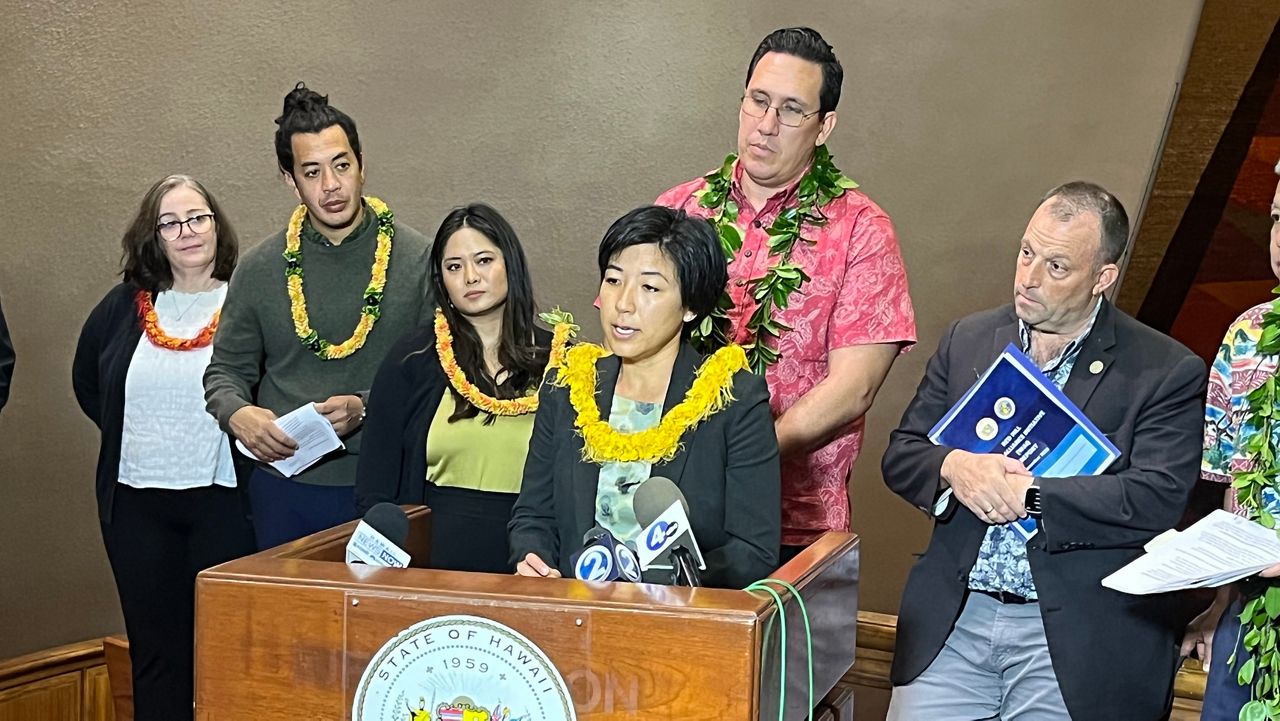HONOLULU — In its much-anticipated final report on the Red Hill water contamination crisis, the Red Hill Water Alliance Initiative, a coalition of state and county leaders, called for an integrated approach to remediating the site, monitoring the ecosystem, assuring continued attention to those exposed to harmful chemicals, coordinating policies and providing public education.
If pursued as is, the recommendations of the report would cost an estimated $750 million, according to state Rep. Linda Ichiyama.
The coalition said it would expect the federal government to foot the bill.
Representatives of the Red Hill WAI, including Gov. Josh Green, House Speaker Scott Saiki, Senate assistant majority whip Jarrett Keohokalole, City Council member Radiant Cordero (standing in for chair Tommy Waters) and Board of Land and Natural Resources chair Dawn Chang presented the report at a news conference at the State Capitol on Tuesday.
The group was formed in May when its members signed a unified statement of commitment to preserving access to safe, clean water. In the six months since then, the group has met regularly to conduct research, consult with experts and formulate recommended policies.
“Everyone is on the same page and that’s why we’ve seen results quite quickly,” Green said. “We’ve come a long way, even since May.
”Saiki, who echoed the report’s assertion that the water crisis is an “existential threat” to the people of Hawaii, said immediate steps need to be taken to clean up ground contamination that dates back to the 1940s. He said earlier estimates of the amount of fuel that has spilled into the ground above the aquifer over the last 80 years — about 180,000 gallons — are inaccurate and the actual amount is likely between 664,000 and 2 million gallons.
“We are clear in our shared conclusion: It is not acceptable to take a wait-and-see approach; Immediate action must be taken to ensure clean water now and in the future for Hawaii’s residents.”
The report’s recommendations include adding a “significant number” of wells to form a “sentinel” grid for monitoring purposes and establishing mauka-to-makai ecosystem monitoring and testing.
It further calls for a better understanding of the distribution, movement and characterization of fuels in the ground and in the water table via geographical and hydrological research. It also suggests biodegradation research to model and field test means of accelerating the natural breakdown of fuel contaminants.
Under the recommendations, remediation would involve targeting contaminated areas with safely applied biodegradation treatment to neutralize hazardous substances before they reach the water table.
With regard to public health, the report recommends a long-term health registry to monitor and study effects of acute exposure and periodic review of science relating to long-term exposure to low levels of TPH in drinking water.
In addition, the report also emphasizes the importance of “multi-agency, multi-government coordination, policy formation over time as conditions change and public information and support.”
The report also firmly asserts that the ultimate responsibility for the contamination, its impacts and the means necessary for remediation and recovery rests with the Navy, Department of Defense and U.S. government. To that end, the group wants the federal government to indemnify the state and counties against future legal actions related to the water crisis.
“It is urgent that a way forward be established to address the damages that the Red Hill fuel facility has inflicted on our aina and wai,” Lau said. “Long-term oversight, transparency and accountability on this environmental crisis created by the Navy’s Red Hill fuel facility must be created to ensure that these resources will be remediated and available for generations to come. This report’s recommendations provide a starting place for this effort. Mahalo to our leaders for coming together to begin this process.”
Keohokalole invoked Kahoolawe as an example of the need for immediate and complete commitment to the remediation of environmental damage.
“Several decades ago, a commitment was made by the federal government and the Navy to restore and remediate ground on Kahoolawe after many decades of environmental damage to their naval activities on the island,” he said. “It’s clear at this point that although the federal government’s commitment to restore the island is considered finished, the work on the island is not done.
“The commitment of the Hawaii State Senate to participate in collaboration with the House, with the cabinet and with so many of our county, state and community partners was to ensure that doesn’t happen again,” Keohokalole said. “It was to ensure that with a unified voice, the leadership of government in Hawaii recognizes that it is our responsibility to our community today and for future generations to ensure that we’re taking the initiative in determining clear objectives and expectations and the process that we think needs to be followed in order to achieve those goals.”
Michael Tsai covers local and state politics for Spectrum News Hawaii. He can be reached at michael.tsai@charter.com.



